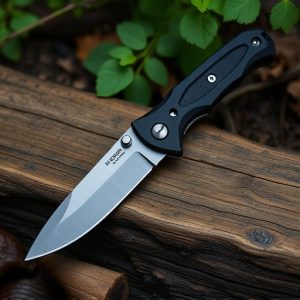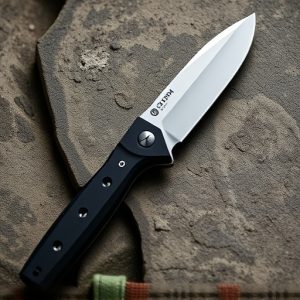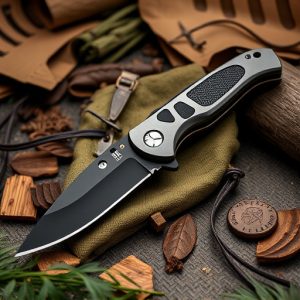Mastering Automatic OTF Knives: Mechanisms, Evolution, Quality Features, and Safety Guidelines
The One-Time-Use Dagger (OtD) mechanism in Out-The-Front (OTF) automatic knives represents a high p…….
The One-Time-Use Dagger (OtD) mechanism in Out-The-Front (OTF) automatic knives represents a high point of engineering for tactical and everyday cutting tools. This one-time deployment feature ensures the blade extends with a trigger or lever activation and locks into place, enhancing safety and stability during use. OTF knives have evolved significantly, starting from basic slide mechanisms to sophisticated devices with enhancements like robust materials, smart technology, and advanced safety features such as finger guards and blade locks. The best OTF automatic knives are made with high-grade stainless steel like AUS-8 or 9Cr1MoV for durability and corrosion resistance. They prioritize ease of use, with a focus on sharp blades that maintain an edge over time, reliable deploying mechanisms, and safety locks to prevent accidental opening. Ergonomic designs ensure a secure and comfortable grip in various conditions. When considering legal issues, it's crucial to understand that OTF automatic knives are subject to the Federal Switchblade Act in the U.S., and users must be aware of the regulations and handle them responsibly to avoid legal consequences and ensure personal safety. Regular maintenance is key to maintaining the knife's functionality and preventing accidents.
Explore the intricate world of automatic OTF (One-Time-Use Dagger) knives, a blend of precision engineering and tactical design. This article delves into the mechanics of these swift devices, tracing their evolution from rudimentary tools to advanced technological marvels. Discover what sets high-quality OTF automatic knives apart, and navigate the legal framework and safety measures crucial for responsible ownership and use. Join us as we unravel the essential aspects of this modern blade technology, ensuring you are well-informed on the subject.
Understanding the OtD (One-Time-Use Dagger) Mechanism in Automatic OTF Knives
The One-Time-Use Dagger (OtD) mechanism in automatic OTF knives is a testament to engineering innovation within the realm of tactical instruments. This proprietary system, inherent to OTF designs, allows for a seamless and rapid deployment of the blade with a single press of a trigger or lever. Upon activation, the knife’s inner components, including the blade, spring assembly, and locking pin, synchronize in a predetermined sequence. The blade shoots out with precision and force, ready for immediate use. Once deployed, the OtD mechanism is designed to prevent re-insertion of the blade back into its handle, ensuring a one-time-use function that adds an element of safety and prevents accidental closure while the knife is in use.
The automatic nature of OTF knives, combined with the OtD mechanism, offers users a dependable tool for various applications, from everyday carry to tactical operations. The durability and reliability of these mechanisms are crucial for users who require swift blade deployment in critical situations. Manufacturers often utilize high-strength materials and precise tolerances to ensure that each OtD mechanism functions smoothly and consistently. This commitment to quality and functionality makes automatic OTF knives a sought-after option for those seeking a versatile, efficient, and reliable cutting tool.
The Evolution of OTF Knife Designs and Technology
The evolution of OTF, or Out-The-Front, automatic knives has been a fascinating journey marked by technological advancements and design refinements that have significantly enhanced their functionality and appeal. Initially conceived as compact and quickly deployable tools for various tasks, OTF automatic knives have transitioned into sophisticated devices with improved mechanisms for smooth operation. The earliest models were characterized by their straightforward construction, featuring a slide that, when activated, pushed the blade out of its frontal housing. Over time, manufacturers focused on refining the internal components, incorporating bearings and high-speed stainless steel blades to ensure durability and precision cutting.
In recent years, advancements in materials science and engineering have led to the development of OTF automatic knives with enhanced safety features, such as finger guards and blade locks, making them more user-friendly and compliant with evolving regulations. The integration of ambidextrous design elements has expanded their accessibility to users of all preferences. Additionally, the emergence of smart technology within these devices has introduced features like motion sensors and electronic safety mechanisms, further elevating the OTF automatic knife from a mere tool to a technologically advanced piece of gear. Today’s OTF automatic knives are not only more reliable but also offer a level of sophistication that was unimaginable in earlier iterations.
Key Features to Look for in a High-Quality Automatic OTF Knife
When selecting a high-quality automatic OTF (One-Time-Fly) knife, discerning users should prioritize durability and reliability in design. A robust construction, often achieved through high-grade stainless steel, ensures longevity and resistance to corrosion. The blade material, typically a premium stainless steel like AUS-8 or 9Cr1MoV, strikes a balance between sharpness and ability to retain an edge. Look for an automatic OTF knife with a deploying mechanism that operates smoothly and consistently, as this feature is the hallmark of the knife’s functionality. The deployment should be swift and one-handed, allowing for quick access in critical situations.
Safety mechanisms are another crucial aspect. A reliable locking system, such as a liner lock or frame lock, ensures the blade remains securely closed when not in use. Additionally, an integrated safety feature to prevent accidental deployment during transport or storage is essential. Ergonomics also play a significant role; a knife that fits comfortably in the hand and provides a secure grip, even when wet or oily, will perform reliably under various conditions. Lastly, consider the overall length of the knife when both open and closed to ensure it meets your legal requirements and practical needs for carry and use. Attention to these key features will help you identify an automatic OTF knife that combines efficiency with safety, making it a valuable tool for everyday tasks or emergency situations.
Legal Considerations and Safety Protocols for Owning and Operating an OTF Knife
When considering the acquisition and use of an OTF (Out-The-Front) automatic knife, it’s crucial to be aware of the legal framework governing their ownership and operation. Laws vary by jurisdiction, so potential owners must familiarize themselves with local, state, or federal regulations. In the United States, for instance, the possession of an OTF knife is regulated under the Federal Switchblade Act, which defines a switchblade as any knife with a spring mechanism or other device in or attached to handle, which releases the blade automatically by hand pressure applied to the handle. Owners must adhere strictly to these laws, as unauthorized possession can lead to legal consequences.
Safety protocols are equally important when operating an OTF automatic knife. Users should engage only with proper training, as the mechanism can be a hazard if not handled correctly. It’s imperative to keep fingers clear of the blade and its mechanisms during operation to prevent injury. Regular maintenance is also vital; ensuring that the moving parts remain lubricated and functional can prevent malfunctions or unexpected deployments. Users should always be mindful of their surroundings and the potential risks involved with carrying such a device. Education on responsible ownership, safe handling practices, and understanding the consequences of misuse are essential for anyone considering an OTF automatic knife for personal or professional use.


